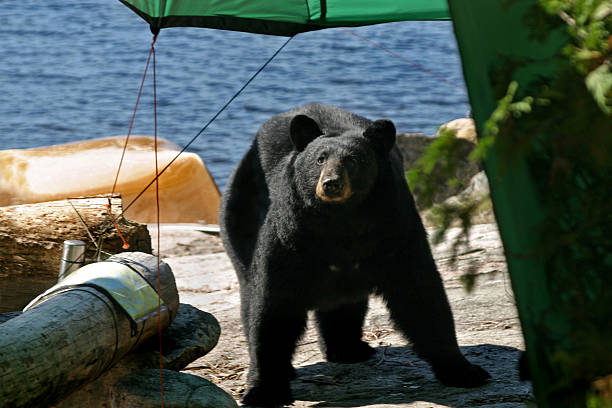Venturing into the wilderness is an exhilarating experience, offering the chance to escape the confines of daily life and immerse yourself in nature’s wonders. However, even the most idyllic trail hides potential hazards. Having a solid grasp of essential safety gear and how to use it is crucial for any responsible adventurer, from casual hikers to intrepid overlanders. This guide will delve into the key tools for navigating wildlife encounters and ensuring a safe return when unforeseen emergencies arise on the trail.
Wildlife Encounters: Prevention and Deterrents
- The Humble Whistle: A Powerful Signaling Tool: A simple whistle might seem like a trivial piece of gear, but its value far exceeds its size. The piercing sound travels a remarkable distance, cutting through dense foliage and harsh weather. Whether you become disoriented, injured, or simply separated from your hiking group, a series of sharp blasts can alert potential rescuers and aid in pinpointing your location. For the most convenient access, keep your whistle attached to an easily reachable spot like your backpack’s sternum strap. Additionally, a whistle’s startling noise can deter curious animals, potentially discouraging close encounters.
- Bear Spray: Your Last Line of Defense: Exploring regions with bear populations means being prepared with bear spray. This highly concentrated form of pepper spray is designed to temporarily incapacitate aggressive bears without causing lasting harm. Here’s what you need to know:
- Accessibility is Key: Bear spray is worthless if it’s inaccessible when needed. Holsters designed for rapid deployment from your hip or chest are a worthwhile investment.
- Practice Makes Perfect: In a stressful bear encounter, you don’t want to fumble with unfamiliar gear. Take the time to practice properly accessing and aiming your spray before you embark on your trip.
- The Wind Factor: Always be aware of wind direction. If it’s blowing toward you, the spray could be ineffective or even incapacitate you instead of the bear.
Important: Bear spray is a last resort tool and should only be deployed if a bear displays aggression or charges.
Emergency Communication: When Cell Service Fails
In the backcountry, relying on your cell phone for help is a risky proposition. If an accident or unexpected detour strands you without service, you’ll need a dedicated communication solution.
- Emergency Beacons: The Power of Satellite Signals: Devices like Personal Locator Beacons (PLBs) or satellite communicators can quite literally be lifesavers. They send SOS signals and your GPS coordinates to search and rescue teams around the world, even in the most remote locations. While these devices and their required subscriptions can be a bit pricey, the peace of mind they provide is immeasurable for serious wilderness exploration.
Navigating Emergencies: First Aid and Navigation Essentials
- The Importance of a Well-Stocked First Aid Kit: A first aid kit isn’t just a box of bandages. A comprehensive kit designed for wilderness adventures should include items like:
- Wound cleansing supplies (antiseptic wipes, gauze pads, adhesive tape).
- Basic medications (painkillers, antihistamines, anti-diarrheal).
- Tools (splinter tweezers, small scissors)
- Emergency supplies (blister treatments, snake bite kit if applicable to your region)
Customize and refresh your kit according to your trip duration and the specific environment you’ll encounter.
- Don’t Get Lost: The Compass and Map Combo: While GPS devices and smartphone apps are handy, don’t underestimate the reliability of old-school navigation tools. A compass and a detailed topographic map of your exploration area are vital backups in the event of technology failure. Familiarizing yourself with their use beforehand is essential. Knowing how to pinpoint your location by matching map features to your terrain is a fundamental skill for avoiding serious mishaps in the wilderness.
- Extra Power: The Key to Keeping Electronics Alive: It’s disheartening when your phone or GPS dies just as you need it most. Invest in portable power banks with enough capacity to recharge multiple devices. Consider solar options for longer expeditions.
- Headlamps and Flashlights: Illuminating the Way: Don’t just rely on your phone’s flashlight. A dedicated headlamp allows you to navigate hands-free at night, essential for setting up camp or dealing with unexpected situations. A regular flashlight provides a more focused beam and offers a backup should your headlamp malfunction.
Additional Considerations: Preparation and Preparedness
- Inform Someone of Your Itinerary: Leave a detailed trip plan with a trusted friend or family member. Include the specific route, expected return date, and vehicle description if applicable. This gives rescuers a starting point if you fail to return on time.
- Knowledge is Power: Take time to research the area you’ll explore. Familiarize yourself with potential hazards like wildlife behavior, weather patterns, and specific regulations.
Conclusion
Exploring the natural world is a privilege, but it comes with inherent risks. By understanding the significance of essential safety tools like whistles, bear spray, emergency beacons, first aid kits, navigation aids, and backup power sources, you empower yourself to manage unexpected situations and ensure an enjoyable – and safe – outdoor adventure.And remember, if your trails take you into the world of thrilling overlanding expeditions, make Kermode Overlanding your go-to resource. We have everything you need to outfit your explorations, ensuring maximum preparedness and peace of mind.





